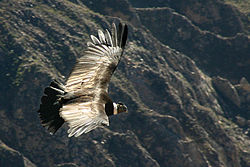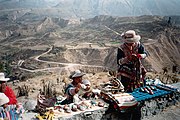Geography
The Colca River starts high in the Andes at Condorama Crucero Alto; below the Colca canyon, as it crosses the plains of Majes it is known as the Majes River, and then is known as the Camana before reaching thePacific Ocean at the town of that name. Within the Province of Caylloma, it is known as the "Colca Valley" between Callalli at the upper end, and Pinchollo/Madrigal at the lower; below that, down to Huambo, it is considered to be the "Colca Canyon." All of the valley, and parts of the canyon are habitable, and Inca and pre-Inca terraces are still cultivated along the less precipitous canyon walls. The town of Chivay (pop. 6,532, INEI 2007) is located at the midpoint of the Colca valley. Above Chivay, at an elevation of 12,000' (3,650 m.), agriculture gives way to livestock raising, principally alpacas and llamas, with some sheep and dairy cattle as well; below Chivay, the valley presents one of the most intensely-terraced landscapes in the world, continuing for many kilometers downstream. Within the deepening valley downriver, a series of small villages is spread out over the approximately 35 miles (56 km) between Chivay and the village of Cabanaconde. The canyon reaches its greatest depth in the region of Huambo, where the river has an elevation of 3,497-ft (1,066-m); in contrast, about 15 miles (24 km) to the southeast of Cabanaconde rises the 20,630-ft (6,288-m) Nevado Ampato, a snow-capped extinct volcano.
[edit]Attractions
The canyon is home to the Andean Condor (Vultur gryphus), a species that has seen worldwide effort to preserve it. The condors can be seen at close range as they fly past the canyon walls, and are the region's most popular attraction. 'Cruz del Condor' is a popular tourist stop to view the condors, an overlook where condors soar gracefully on thermals of warm air rising from the canyon. The condors are best seen in the early morning and late afternoon when they are hunting. At this point the canyon floor is 3,960 feet (1,200 m) below the rim of the canyon.
Other notable bird species present in the Colca include the Giant Colibri, the largest member of the hummingbird family; the Andean Goose; Chilean Flamingo; and Mountain Caracara. Animals include the vizcacha, a rabbit-sized relative of the chinchilla; zorrino, a member of the skunk family; deer; fox; and vicuna, the wild ancestor of the alpaca.
The La Calera natural hot springs are located at Chivay, the biggest town in the Colca Canyon. Other hot springs, some developed for tourist use, are dotted throughout the valley and canyon.
Archeological sites include: the caves of Mollepunko, above Callalli, where rock art (said to be 6,000 years old) depicts the domestication of the alpaca; the mummy of Paraqra, above Sibayo; the Fortaleza de Chimpa, a reconstructed mountaintop citadel that looks down on Madrigal; ruins of pre-Hispanic settlements throughout the valley; and many others.
Activities include hiking, mountain biking, trekking, mountaineering, rafting, horseback riding, fishing, and sightseeing.
Cultural attractions: festivals throughout the year, including the Wititi festival in Chivay, December 8–11; the Wititi has been declared the dance most representative of the Arequipa region, and named as a "cultural heritage" of Peru. The Colca is also well-known for two forms of crafts: goods knitted from 100% baby alpaca fiber (hats, gloves, etc.), and a unique form of embroidery that adorns skirts (polleras), hats, vests, and other items of daily wear and use.
Other attractions: the most distant source of the Amazon River is accessible from the Colca valley via Tuti, a one-day trip to a spring at 16,800 feet (5,120 m), where snowmelt from Nevado Mismi bursts from a rock face; the Infiernillo geyser, on the flanks of Nevado Huallca Huallca, accessible on foot, horseback, or mountain bicycle; and a number of "casas vivenciales," where tourists can stay with a local family in their home, and share in their daily activities.
Autocolca, an autonomous authority created by law in the 1980s, is responsible for tourism promotion and management in the Colca valley. A "tourist ticket" is required for entry to the touristic zone of the Colca; the tourist ticket is currently valued at 35 Nuevos Soles (roughly $12.50) for foreign visitors, half that for Peruvian nationals, to enter the Colca tourist zone.
[edit]Name
The name Colca refers to small granaries of mud and stone, built into the cliffs in the valley and canyon. These repositories were used in Inca and pre-Inca times to store food, such as potatoes, quinoa, and other Andean crops. They were also used as tombs for important people.
[edit]History
The quechua-speaking Cabanas, probably descended from the Wari culture, and the Aymara-speaking Collaguas, who moved to the area from the Lake Titicaca region, inhabited the valley in the pre-Inca era. The Inca probably arrived in the Colca valley around 1320 AD, and established their dominion through marriage, rather than through warfare. The Spaniards, under Gonzalo Pizarro, arrived in 1540, and in the 1570s the Spanish viceroy Francisco de Toledo ordered the inhabitants to leave their scattered settlements and to move to a series of centrally-located pueblos, which remain the principal towns of the valley. Franciscan missionaries built the first chapel in the valley in 1565, and the first church in 1569 (Coporaque).
No passable roads existed between Arequipa and Chivay until the 1940s, when a road was completed to serve the silver and copper mines of the region. In the 1970s and 1980s, the Majes Hydroelectric Project — which diverted water from the Colca River to irrigate crops in the Majes region — built roads within the valley, and opened the area to outsiders. Access today is usually via Arequipa.
In May 1981, the Polish "Canoandes" rafting expedition made the first descent of the river below Cabanaconde, and proclaimed the possibility of its being the world's deepest canyon. It was so recognized by the Guinness Book of Records in 1986, and a National Geographic article in January 1993 repeated the claim. The joint Polish/Peruvian "Cañon del Colca 2005" expedition verified the altitudes of the river and the surrounding heights via GPS in 2005.
Tourism has exploded since the publicity of the 1980s and 1990s, increasing from a few thousand visitors annually, to nearly 150,000 visitors in 2010.






Tidak ada komentar:
Posting Komentar